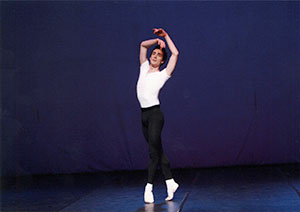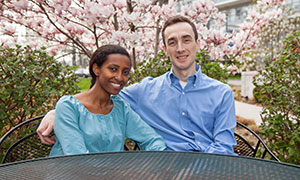

Achieving Élévation as M.D.
From “Mozartiana” to Medicine: Alex Ritter's Remarkable Journey
In her June 11, 1996 review of George Balanchine’s “Mozartiana,” New York Times dance critic Anna Kisselgoff commended soloist Alexander Ritter, noting, “One hopes not to wait long for Mr. Ritter to dance the leading role in this ballet. In the meantime, he poured into the quirky ‘Gigue’ solo of “Mozartiana” all the flourish of a Moliere and the classical form of a Racine.”
Once an acclaimed ballet dancer, today Mr. Ritter is preparing to graduate from medical school. And, despite the obvious differences between dancing and doctoring, the fourth-year Einstein medical student believes the two fields actually have a lot in common.

Alex Ritter during his career as a ballet dancer“Requirements for success in either include discipline, hard work, life-long practice and learning, as well as openness to criticism,” noted Mr. Ritter. “And, whether you’re dancing onstage or seeing a patient, you have to be immersed in the present moment or you might either drop a ballerina, or fail to listen to or see the patient.”
First Steps
Mr. Ritter’s long journey began in 1982, when he attended his first ballet class at age 12, along with his younger brother and sister – and loved it. Growing up in Ottawa, Canada, he had always enjoyed sports, including baseball, hockey, and soccer. But ballet thrilled him in a way that went beyond scoring goals and winning. “What captivated me was the emotional quality that was created by pairing music with a focused physical effort.”
Recognizing his potential, Alex’s dance teacher suggested that he audition for the National Ballet School of Canada, which is affiliated with Canada’s National Ballet. Alex was accepted and left Ottawa for Toronto, where he attended the school from 8th through 12th grades – dancing and laying the groundwork for his medical career.
“From an early age, before I knew I wanted to be a dancer, I dreamed of being a doctor,” he recalled. “So, in high school, I took all the sciences.”
In spite of his inkling about medicine, Mr. Ritter was awarded an apprenticeship at the National Ballet of Canada. He joined the company, rising to the role of soloist over two and a half years. Then, seeking a change, he moved to New York, first earning a position with the American Ballet Theater, and ultimately joining the New York City Ballet (NYCB) in 1992, where he found his niche and remained until 2002.
A Pivotal Experience
While sidelined after an Achilles tendon injury, Alex became painfully aware that a dancer’s career is finite. He enrolled at Fordham University to begin to explore what to do with the rest of his life. While he did make a full recovery from his surgery and kept dancing with NYCB, he eventually decided to leave that company in order to freelance with other companies while also devoting himself to full-time academic study. He ultimately graduated from Fordham in 2009.
As Alex pursued his studies, his older sister’s 45-year-old husband, Judah, was diagnosed with recurrent metastatic breast cancer. Even as it became clear after several rounds of chemotherapy and complications of the cancer, that Judah wasn’t going to survive, active medical interventions continued despite his complaints of the ever-increasing burden on his quality of life. Because there was no advance directive in place, the family’s default was “Do everything… As a result, no palliative care or hospice was offered until the day prior to Judah’s death. That was understandable given his young age, but at the same time there also seemed to be a disconnect with the patient that caused him to suffer unnecessarily.”
That experience, along with his love of science and fond memories of the physician who had cared for students at the National Ballet School, led him to apply to medical school. “That general practitioner provided solace to homesick dancers, along with vaccinations and sick visits. He looked at the whole patient and provided whole-person care.” Looking back on that experience, Alex was drawn to primary care and specifically, family medicine, even before he set foot in medical school.
Among the medical schools Mr. Ritter applied to, Einstein was a top choice. “I was impressed by its history of caring for underserved populations and its commitment to recruiting students from diverse backgrounds,” he said.
A New Partnership

Alex with his wife, Seble During the summer following first year, Mr. Ritter took the opportunity to travel to Ethiopia with Dr. Carol Harris. While there, he produced a survey of acute malnutrition in the pediatric population, and also met his future wife Seble Solomon, an Ethiopian general internist/obstetrician-gynecologist, who was working in the same hospital. After a whirlwind romance, the two stayed in close touch thanks to Skype and Ethiopian Airlines, and are looking forward to continuing their lives together here in the States.
“Many consider it unfortunate when physicians leave their native country to practice elsewhere, especially when there is such dire need back home. However, we see it a little differently. While Seble has already paid her dues for her education through service, she also loves her country very much, and in actual fact, Ethiopia has gained two physicians for the price of one,” explained Mr. Ritter. Both he and Seble plan on returning to Ethiopia to practice family medicine and women’s health, respectively, during residency and beyond.
And, while Mr. Ritter never had the opportunity to tackle “Mozartiana’s” lead role, he continues to dance – taking occasional classes at Steps on Broadway, with his teacher, David Howard, and pairing up with his wife, who wants to learn salsa.
Posted on: Tuesday, May 7, 2013

Tablet Blog